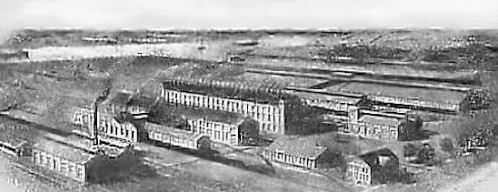- Details
- Hits: 2867
Location: Hecla Portland Cement Company, Bay City, MI

This cement works was organized in 1901 by Julius Stroh (of Detroit's Stroh Brewery Company) and other Detroit investors. They built a large cement plant along the Saginaw River and a railroad from the cement works west to bring coal, marl and other products into the plant.
Notes
The business plan was to mine coal from fields northwest of Bay City, sell the larger pieces on the open market and use the "slack" to heat kilns to produce Portland Cement at the plant. Cement would be shipped by barrel, and coal shipped by lake freighters (loaded from coal loading facility on site). The plant would also use excess steam and boil away brine to produce salt. The brine was pumped from underground deposits in the area.
The company identified four coal fields in the area of Wenona and Auburn, but only one ever produced fuel for the plant. The company expected to mine marl from lakes which were located along Michigan Central tracks along the Tittabawaee River in Ogemaw County.
The plant, which was built along 1,000 feet of Saginaw River frontage and went into operation in mid-1902. The first coal mine was also sunk about this time. By 1903, the plant was in receivership,
A 1912 Sanborn map indicates that the plant had a single stall engine house. [SBM]
This plant was located on the north side of the Saginaw River in Bangor Township. 43.616573, -83.852280
Time Line
1903. George Burbank, formerly manager of the Hecla Belt Line railway and traffic superintendent of the Hecla Cement Co., has been put in charge of the company's property by the Detroit Trust Co., receiver. Mr. Burbank says that the present trouble is only of a temporary nature and that the affairs of the company will undoubtedly shape themselves satisfactorily in a short time.
Burbank wants a deeper channel into the Saginaw river, as the largest class of lake boars could then enter and his company could ship its cement to the northwest at a low rate. [BCE-1903-1015]
1904, The company was in financial trouble and the Detroit Trust Company filed a foreclosure suit.
1907, The company was reorganized with new plans to use limestone and shale in the production of Portland Cement, rather than marl and shale.
1912, Cement producing equipment had been removed from the plant and the facility was sold to unnamed investors for other industrial purposes.
After 1912. The railroad connecting the plant with the Michigan Central's Wenona Yard was ultimately transferred to the MC and become its Hecla Belt Line branch serving industry along Wilder Road and an interchange with the D&M.
1913. The Hecla Belt Line railroad, about three miles long, has been purchased by the Michigan Central, according to report here today. The road connects the defunct Hecla Cement Co.'s plant with the MC tracks. The purchase price is said to be $50,000. Most of the machinery in the old plant has been sold to a Kansas cement concern. [DET-1913-0114]
Sources
- Geological Survey of Michigan, Clays and Shales, by H. Reis, 1902
- The Michigan Miner, 1902.
- State of Michigan, Bureau of Labor and Industrial Statistics, 1907
- Michigan Manufacturer and Financial Record, 1912.
Bibliography
The following sources are utilized in this website. [SOURCE-YEAR-MMDD-PG]:
- [AAB| = All Aboard!, by Willis Dunbar, Eerdmans Publishing, Grand Rapids ©1969.
- [AAN] = Alpena Argus newspaper.
- [AARQJ] = American Association of Railroads Quiz Jr. pamphlet. © 1956
- [AATHA] = Ann Arbor Railroad Technical and Historical Association newsletter "The Double A"
- [AB] = Information provided at Michigan History Conference from Andrew Bailey, Port Huron, MI

